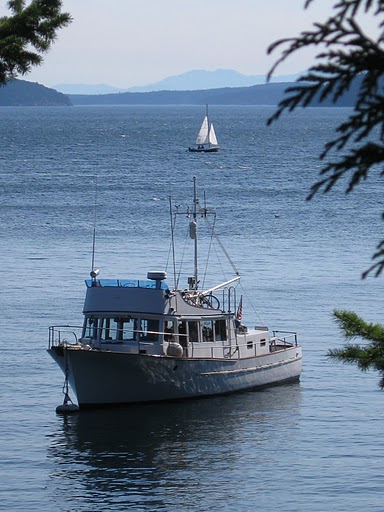For the 12 months ending Oct 2012: mvVikingStar.blogspot.com/../update-to-viking-stars-energy-use-per
12 months ending Jan of 2011: mvVikingStar.blogspot.com/../viking-star-average-energy-usage
OK, so I have not been that consistent, nor fixed with October. But who knows, maybe with two in a row a trend is starting!
How much energy do we use in a year?
Lets review. Kristi and I use energy, just like most any person in the world does. But as we live in a very small house and do not have a car, we use noticeably less energy than the average American. We are full time cruisers and spend from the end of February to the beginning of November 'Out There'. During those 8+ or so months we are fully dependent upon ourselves for energy production as well as, depending on how 'Far Out' we get, water production. During the core of the winter months we tend to come in and rent a transient slip, to get easy access to coffee shops and less-muddy trails.Our source for Energy is primarily Diesel fuel, with a little Propane and Gasoline thrown in. And with that we move ourselves, heat our space and water, cook our food, generate our electricity, even make our drinking water as needed. And for the last couple of years we have supplement our electrical needs with two Solar panels (mvVikingStar.blogspot.com/search/label/Solar) When in port we try to use the shore power cord as much as possible because, truth be told, shore based energy is dramatically less expensive then on-board generation.
Over the past 12 months energy consumption on Viking Star has been:
- 500 Gallons (320g for the Mains, 50 in the Gen/WM, and 120 for the Hurricane heater, maybe 10 more for the Dickenson)
- 8 Gallons of Gasoline for the dinghy outboard motor
- 15 Gallons of Propane for the stove and BBQ
- 4,900KWh of Electricity while in port.
Running these all through conversions into a common energy measurement ( BTUs ) the above comes to 88 Million BTUs for the two of us. A massive reduction from the prior years 116 MBTUs, continuing the downward trend from 140 MBTUs the year before that. What changed? Biggest change is how we heat during the Winter. Up until last winter we had heated primarily with the Dickinson Diesel stove, a heater we still love for its warm dry heat. But it is NOT the most efficient, only because it tends to be an all-or-nothing heater. These days we rely on the Hurricane hydronic heater to warm the boat up in the morning, and let the electric space heaters take over and carry us throughout the day and into the evening. That is perhaps the biggest change. Solar helped some as well (See below)
As with prior years energy use of rental car / bus usage was not tracked; if we add say an extra 50 gallons of gas for the rental cars and buses we use, that adds another 6-7 MBUTs. Lets 'Round up' our yearly energy usage to 95 MBUTs for the two of us, or a little under 50 MBTUs each in direct energy consumption.
 How does this stack up?
How does this stack up?
Going to be lazy here and just assume the average energy consumption per person has not changed that much from last year to this. Hence am reusing last years 'chart'. Converting the US Average of 98,418KWhs of energy consumption per person into BTUs we still get 336 MBTUs per-person.336 MBTUs vs. 50 MBTUs. Yes, living the Small Life on Viking Star we use less then 1/6th the amount of energy an average US citizen does.
One Sixth...
In fact, we even use less energy than the average world-wide citizen does (at 72 MBTUs).
Living the Small Life on a Boat can be very very energy efficient, even if it is a 50 year old boat..
How much does it cost?
Doing a rough translation of the fuel used above (ala, using $4/gal for Diesel, etc.) I come to a yearly cost of around $2,500. Add in a couple hundred for Rental Car fuel, and we are at a yearly energy cost of around $2,700 .Which points out a big truth about Energy on boats: We may use little, but what we use costs a LOT. Hence the real strong focus on energy savings, LED lighting, efficent refridguration, Solar / Wind generation.
So, how does this compare to the direct energy costs you see in a year? Electricity, Oil, Natural gas, Auto Gasoline, etc...
A note on the Solar Panels ROI
I added up the number of AHs produced over the past 12 months and it came to around 31,500Ahs of electricity produced. This translates into over 260 hours of time we did NOT need to run the generator. To date we have offset almost 45% of the cost of the solar installation by not running the generator, well on the way to achieving ROI in 3-4 years.Energy. As a cruising boat we know we use a lot more than others. Between space heating, movement, computers, refrigerator and freezer, we are kind of an energy pig. But I think looking at the lifestyle, it is clear we are comparatively but a wee-little one.








































